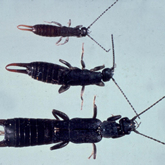Black field earwig

Black field earwigs - 3 different sizes
The black field earwig is one of several soil pests that can damage young seedlings. It's a native species that normally feeds on decaying stubble in cultivation. All stages (adults and immatures) are present during warmer months.
Scientific name
Description
Adults are 15mm long, shiny black with a flattened body and a pair of curved pincers at the end of the body.
Nymphs resemble adults but are wingless and the pincers are paler.
May be confused with
The predatory common brown earwig (Labidura truncata) is larger (24mm) and lighter in colour than the black field earwig.
The European earwig (Forficula auricularia) is slightly larger (12–24mm) with a dark body and orange legs, but is more commonly found in southern regions.
Distribution and habitat
Widespread across Australia, but mainly a pest in areas with heavy, black soils.
Earwigs prefer cultivated soil rather than undisturbed soil (zero till).
Hosts
Wheat, sorghum, maize and sunflowers are the preferred hosts, but seedlings of most field crops are susceptible.
Damage
Nymphs and adults eat newly sown and germinating seed and crop roots, resulting in poor establishment. Feeding on secondary roots may cause lodging (the plants fall over as they get larger).
Life cycle
- Females lay eggs in a burrow in the soil and remain to care for the eggs and nymphs.
- Eggs hatch in 6–7 days at 29°C.
- Nymphs develop through 5 instars in about 7 weeks in clay soils, but take longer in sandy soils.
- Nymphs develop into adult females or major or minor males.
- Earwigs live for about 20 weeks.
Monitoring and thresholds
Use germinating seed baits or digging and sieving to detect adults and nymphs before planting. Monitor crops after planting until establishment.
Control if:
- more than 50 earwigs in 20 germinating seed baits
- 1 or more earwigs in 20 spade samples.
Control
- For best protection, apply grain baits containing insecticide at sowing.
- Insecticide seed dressings provide some protection.
- In-furrow sprays are not effective against dense populations.
- Use press wheels at sowing. Set at 2–4kg per cm width after planting rain, or 4–8kg per cm in dry soil.
Further information
- European earwig—Cesar PestNotes
- Video on using germinating grain baits—The Beatsheet
- Registered chemicals database—Australian Pesticides and Veterinary Medicines Authority (APVMA)